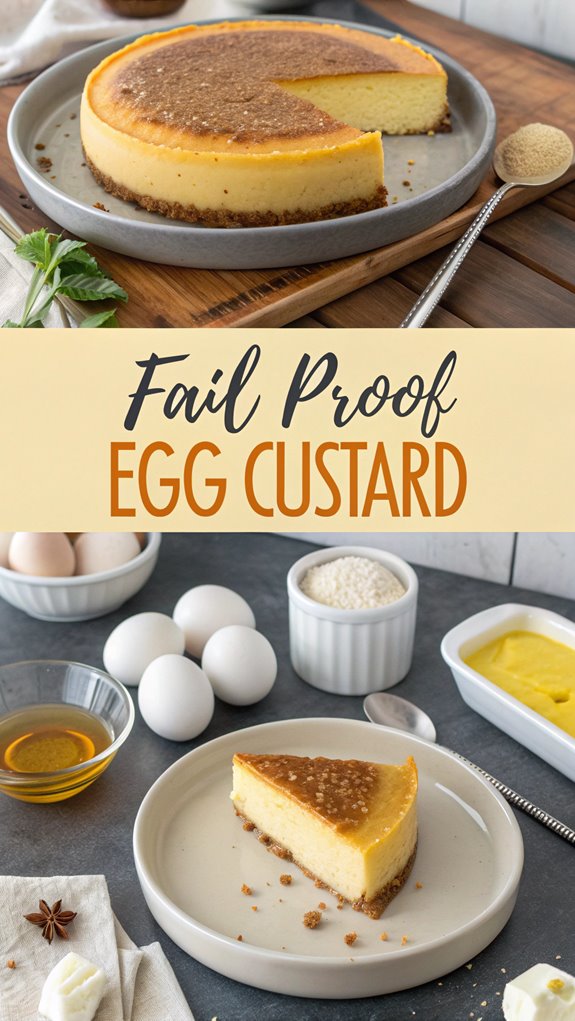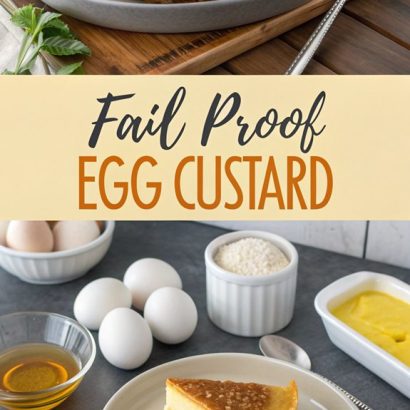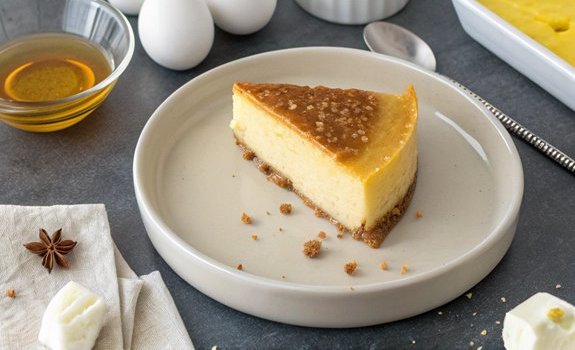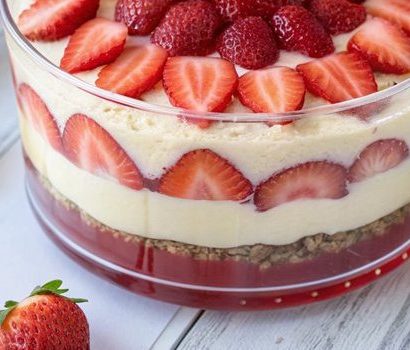Fail Proof Egg Custard
Just like a well-crafted story, the perfect fail-proof egg custard unfolds with careful attention to detail. You’ll discover how easy it is to create this creamy dessert, which can be enjoyed warm or chilled. By mastering the technique of gradually mixing hot milk with eggs, you can avoid common pitfalls like curdling. Curious about the best ingredients and variations to try? Let’s explore the ins and outs of making this classic treat.
Why You’ll Love This Recipe
When you try making egg custard, you’ll quickly discover why this recipe is a favorite for many. The classic ingredients—eggs, milk, sugar, and often vanilla—create a rich and creamy dessert. You can also customize your custard by adding flavors like cinnamon, nutmeg, or chocolate. Plus, you can experiment with different types of milk, such as almond or coconut, to suit your taste. To achieve that smooth texture everyone loves, it’s essential to heat the milk correctly and gradually mix it with the eggs while whisking. Using different milk options like almond or coconut can enhance the flavor and cater to various dietary preferences. Baking in a water bath keeps the temperature even, ensuring your custard sets perfectly. Whether served hot or cold, this delightful treat is sure to please anyone.
History
Custard has a rich history that stretches back to ancient times, showcasing its evolution across various cultures.
Ancient Roman cooks experimented with eggs, creating dishes like patinae and crustades. They enjoyed both savory and sweet egg-based desserts, often flavored with honey and nuts.
In Asia, similar custard recipes developed, showing its widespread appeal.
During the Middle Ages, custard became popular as fillings for pies and pastries.
The 17th century saw set custards rise in Britain, aided by advancements in ovens.
Alfred Bird’s invention of custard powder in 1837 made this beloved dessert accessible worldwide.
Today, custard continues to evolve, adapting to various cultures while remaining a cherished treat in many kitchens.
Recipe

Ingredients:
– Whole milk or 2% milk
– 5 large eggs
– ½ cup sugar
– 1½ teaspoons vanilla extract
– ½ teaspoon salt
– Nutmeg (optional for topping)
Cooking Instructions:
- Preheat your oven to 350°F and lightly grease an 8×8 inch baking dish.
- In a saucepan, heat the milk over medium heat until it reaches approximately 180°F, being careful not to let it boil.
- In a separate bowl, whisk together the eggs, sugar, vanilla extract, and salt until well combined.
- Gradually pour the hot milk into the egg mixture while whisking constantly to temper the eggs and prevent scrambling.
- Continue whisking the mixture for an additional minute after incorporating the milk. If desired, strain the mixture to remove any bits of cooked egg.
- Place the greased baking dish in a larger pan and pour the custard mixture into the baking dish. Fill the larger pan with about 1 inch of hot water to create a water bath.
- Bake in the preheated oven for 45 to 50 minutes, or until a knife inserted into the center comes out clean but the custard still jiggles slightly.
- Carefully remove the baking dish from the water bath and allow the custard to cool before serving.
For best results, keep these extra tips in mind while preparing your egg custard.
Always whisk the mixture thoroughly to guarantee even consistency, and be careful not to overbake it, as this can lead to a rubbery texture. Additionally, using whole or 2% milk will enhance the creaminess and texture of your custard.
Using fresh, high-quality ingredients will enhance the flavor and texture of your custard.
Finally, feel free to experiment with toppings such as whipped cream, fresh fruit, or a sprinkle of nutmeg for added flair.
Enjoy your homemade egg custard!
Final Thoughts
As you wrap up your egg custard journey, remember that practice leads to perfection.
Focus on key elements like temperature control, maintaining your oven at 350°F, and using a hot-water bath for even cooking. When adding milk, pour it slowly to avoid scrambling the eggs. Always test for doneness with a thin-bladed knife—remove the custard before it’s fully set to prevent curdling.
Don’t forget to strain the mixture to eliminate tough strands. Keep an eye on your baking time and resist the urge to open the oven door, as this can affect texture. For a perfectly smooth texture, utilize a sieve to strain your custard mixture before baking.
Finally, let your custard cool properly on a wire rack for the best results. Enjoy your delicious creation!
FAQ
When you’re diving into making fail-proof egg custard, it’s common to have questions about the process. To prevent curdling, always temper your eggs by slowly adding hot milk while whisking. Baking in a water bath helps maintain even temperatures, preventing overcooking. If your custard seems lumpy, an immersion blender can quickly smooth it out.
For undercooked custard, cook for an additional 1 to 2 minutes after bubbles appear. Use whole or 2% milk for the best texture, and choose fresh eggs. Remember to preheat your oven to 325°F or 350°F, and bake until slightly jiggly in the center. Stirring frequently during stovetop preparation is also essential to maintain a consistent temperature and prevent curdling. Store your custard in the fridge for up to three days, and enjoy it chilled or warm!

FAIL PROOF EGG CUSTARD
Ingredients
- Ingredients:
- - Whole milk or 2% milk
- - 5 large eggs
- - ½ cup sugar
- - 1½ teaspoons vanilla extract
- - ½ teaspoon salt
- - Nutmeg optional for topping
Instructions
- Cooking Instructions:
- Preheat your oven to 350°F and lightly grease an 8×8 inch baking dish.
- In a saucepan, heat the milk over medium heat until it reaches approximately 180°F, being careful not to let it boil.
- In a separate bowl, whisk together the eggs, sugar, vanilla extract, and salt until well combined.
- Gradually pour the hot milk into the egg mixture while whisking constantly to temper the eggs and prevent scrambling.
- Continue whisking the mixture for an additional minute after incorporating the milk. If desired, strain the mixture to remove any bits of cooked egg.
- Place the greased baking dish in a larger pan and pour the custard mixture into the baking dish. Fill the larger pan with about 1 inch of hot water to create a water bath.
- Bake in the preheated oven for 45 to 50 minutes, or until a knife inserted into the center comes out clean but the custard still jiggles slightly.
- Carefully remove the baking dish from the water bath and allow the custard to cool before serving.
- For best results, keep these extra tips in mind while preparing your egg custard.
- Always whisk the mixture thoroughly to guarantee even consistency, and be careful not to overbake it, as this can lead to a rubbery texture. Additionally, using whole or 2% milk will enhance the creaminess and texture of your custard.
- Using fresh, high-quality ingredients will enhance the flavor and texture of your custard.
- Finally, feel free to experiment with toppings such as whipped cream, fresh fruit, or a sprinkle of nutmeg for added flair.
- Enjoy your homemade egg custard!



